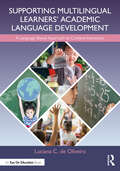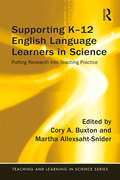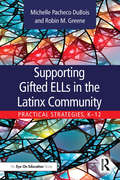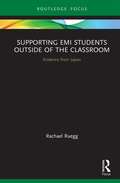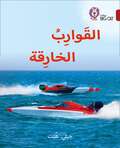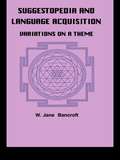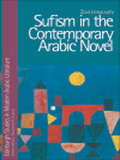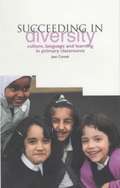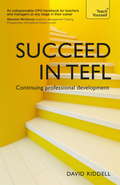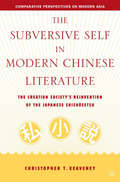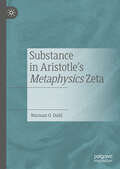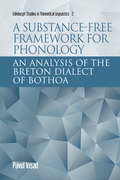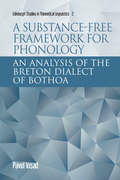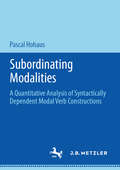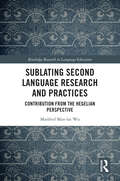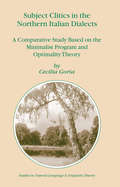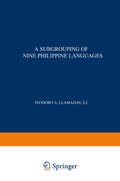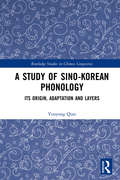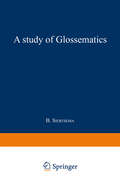- Table View
- List View
Supporting Multilingual Learners’ Academic Language Development: A Language-Based Approach to Content Instruction
by Luciana C. de OliveiraA practical and comprehensive resource, Supporting Multilingual Learners’ Academic Language Development: A Language-Based Approach to Content Instruction introduces an accessible language-based approach to teaching academic language to multilingual learners across the content areas. Luciana C. de Oliveira provides elementary school teachers with everything they need to know to successfully teach grade-level content to multilingual learners. Chapters are organized by subject, addressing the specific language demands of teaching English language arts, social studies, mathematics, and science. Each chapter features examples of implementation in grades K-5, practical strategies, and a wealth of tables, figures, and other resources. The Language-Based Approach to Content Instruction (LACI) in this book provides teachers with a ready-to-use framework of six scaffolding elements that serves as a guide to enable multilingual learners to meet the grade-level standard of their peers without simplification. Aligned with WIDA and CCSS standards, this resource provides the tools and methods teachers need to support multilingual learners’ academic language development in the content area classroom.
Supporting K-12 English Language Learners in Science: Putting Research into Teaching Practice (Teaching and Learning in Science Series)
by Cory Buxton Martha Allexsaht-SniderThe contribution of this book is to synthesize important common themes and highlight the unique features, findings, and lessons learned from three systematic, ongoing research and professional learning projects for supporting English learners in science. Each project, based in a different region of the U.S. and focused on different age ranges and target populations, actively grapples with the linguistic implications of the three-dimensional learning required by the Framework for K-12 Science Education and the Next Generation Science Standards. Each chapter provides research-based recommendations for improving the teaching of science to English learners. Offering insights into teacher professional learning as well as strategies for measuring and monitoring how well English learners are learning science and language, this book tells a compelling and inclusive story of the challenges and the opportunities of teaching science to English learners.
Supporting K-12 English Language Learners in Science: Putting Research into Teaching Practice (Teaching and Learning in Science Series)
by Cory Buxton Martha Allexsaht-SniderThe contribution of this book is to synthesize important common themes and highlight the unique features, findings, and lessons learned from three systematic, ongoing research and professional learning projects for supporting English learners in science. Each project, based in a different region of the U.S. and focused on different age ranges and target populations, actively grapples with the linguistic implications of the three-dimensional learning required by the Framework for K-12 Science Education and the Next Generation Science Standards. Each chapter provides research-based recommendations for improving the teaching of science to English learners. Offering insights into teacher professional learning as well as strategies for measuring and monitoring how well English learners are learning science and language, this book tells a compelling and inclusive story of the challenges and the opportunities of teaching science to English learners.
Supporting Gifted ELLs in the Latinx Community: Practical Strategies, K-12
by Michelle Pacheco DuBois Robin M. GreeneThis essential resource is designed to help your classroom, school, or district better identify and serve gifted English language learners in the Latinx community. Drawing on detailed case studies and vignettes from actual programs, chapters highlight the unique needs of gifted Latinx English language learners, and look at how you can best identify and support their development. Covering topics from teacher bias and systemic racism to best practices for engaging families and communities, this book lays out practical strategies and an accessible framework for implementing culturally responsive assessments, identification, and programming strategies.
Supporting Gifted ELLs in the Latinx Community: Practical Strategies, K-12
by Michelle Pacheco DuBois Robin M. GreeneThis essential resource is designed to help your classroom, school, or district better identify and serve gifted English language learners in the Latinx community. Drawing on detailed case studies and vignettes from actual programs, chapters highlight the unique needs of gifted Latinx English language learners, and look at how you can best identify and support their development. Covering topics from teacher bias and systemic racism to best practices for engaging families and communities, this book lays out practical strategies and an accessible framework for implementing culturally responsive assessments, identification, and programming strategies.
Supporting EMI Students Outside of the Classroom: Evidence from Japan (Routledge Focus on English-Medium Instruction in Higher Education)
by Rachael RueggThere is a growing body of research on English-medium Instruction (EMI) in Asian contexts, and much of this research points out difficulties experienced by stakeholders. This volume takes up the issue of support for EMI, which is, and which can be, offered to students outside of the classroom in order to help them succeed academically in an EMI environment. Dr Ruegg’s book demonstrates the effectiveness of such support in the Japanese context. It begins by examining the support currently available for students in English-medium full degree programmes then goes on to examine one successful support service in more detail in order to determine the kinds of effects that can be achieved by establishing such a centre. The research reported in this book was conducted in Japan, but the findings will apply in other locations, especially in other Asian countries. The information provided in the book is expected to inform institutions who are looking to either establish an English-medium degree programme or improve on an existing programme by sharing information about the practices of other institutions.
Supporting EMI Students Outside of the Classroom: Evidence from Japan (Routledge Focus on English-Medium Instruction in Higher Education)
by Rachael RueggThere is a growing body of research on English-medium Instruction (EMI) in Asian contexts, and much of this research points out difficulties experienced by stakeholders. This volume takes up the issue of support for EMI, which is, and which can be, offered to students outside of the classroom in order to help them succeed academically in an EMI environment. Dr Ruegg’s book demonstrates the effectiveness of such support in the Japanese context. It begins by examining the support currently available for students in English-medium full degree programmes then goes on to examine one successful support service in more detail in order to determine the kinds of effects that can be achieved by establishing such a centre. The research reported in this book was conducted in Japan, but the findings will apply in other locations, especially in other Asian countries. The information provided in the book is expected to inform institutions who are looking to either establish an English-medium degree programme or improve on an existing programme by sharing information about the practices of other institutions.
Suggestopedia and Language
by W. Jane BancroftFirst published in 1999. Routledge is an imprint of Taylor & Francis, an informa company.
Suggestopedia and Language
by W. Jane BancroftFirst published in 1999. Routledge is an imprint of Taylor & Francis, an informa company.
Sufism in the Contemporary Arabic Novel
by Ziad ElmarsafySufi characters – saints, dervishes, wanderers – occur regularly in modern Arabic literature. A select group of novelists to interrogate Sufism as a system of thought and language. In the work of writers like Naguib Mahfouz, Gamal Al-Ghitany, Taher Ouettar, Ibrahim Al-Koni, Mahmud Al-Mas’adi and Tayeb Salih we see a strong intertextual relationship with the Sufi masters of the past, including Al-Hallaj, Ibn Arabi, Al-Niffari and Al-Suhrawardi. This relationship becomes a means of interrogating the limits of the creative self, individuality, rationality and the manifold possibilities offered by literature, seeking in a dialogue with the mystical heritage a way of preserving a self under siege from the overwhelming forces of oppression and reaction that have characterised the late 20th and early 21st centuries.
Succeeding In Diversity: Culture, Language And Learning In Primary Classrooms (PDF)
by Jean ContehJean Conteh traces a group of successful bilingual learners as they progress through Key Stage 2 in mainstream classrooms to show how successful children are helped by their interactions and experiences at home and school to move confidently between social worlds, cultures and languages in their daily lives. These are the fortunate children: the skills, knowledge and strategies they display in all these interactions are, as Dr Conteh describes, recognized and valued in classroom pedagogy and in assessing their achievements in school. But they are the exception - most bilingual learners are still condemned to failure in school. The implications for educational policy, teacher education and classroom practice of this case study are set out and linked in new ways with established knowledge and ideas about linguistics, learning and language in the mainstream classroom. Supported with practical suggestions and resources, this book should enable primary teachers to provide what bilingual children in their class need to learn successfully.
Succeed in TEFL - Continuing Professional Development: Teaching English as a Foreign Language with Teach Yourself (Continuing Professional Development In E Ser.)
by David RiddellThe ultimate guide for developing your career as an English teacher.Succeed in TEFL is packed with information on how to develop within the profession including chapters on:-getting the most out of observations-teaching exam classes-becoming a trainer -doing action research-using online resources-becoming a manager-and much more!This is an indispensable book for all EFL teachers: a conclusive guide to making the most of your teaching experience and moving ahead in your career. The author draws on his wealth of knowledge in the fields of teaching, training and management to address the key issues facing today's EFL teachers. Also included is a range of case studies and interviews from teachers with experience of working in different countries and contexts. These bring fresh insight to the topics, which combined with numerous tasks, makes this an engaging and practical Continuing Professional Development (CPD) handbook. This book is ideal for teachers looking for new ways to develop their expertise as well as academic managers wanting fresh ideas on how to foster Continuing Processional Development (CPD) in their staff.Rely on Teach Yourself, trusted by learners for over 75 years.
The Subversive Self in Modern Chinese Literature: The Creation Society’s Reinvention of the Japanese Shishôsetsu (Comparative Perspectives on Modern Asia)
by C. KeaveneyAn examination of whether Chinese writers of the Creation Society, a Chinese literary coterie, successfully appropriated shishosetsu, a quintessentially Japanese form of autobiographical narrative, into a form to be exploited for their own ends, especially political ends.
Substance in Aristotle's Metaphysics Zeta
by Norman O. DahlThis book argues that according to Metaphysics Zeta, substantial forms constitute substantial being in the sensible world, and individual composites make up the basic constituents that possess this kind of being. The study explains why Aristotle provides a reexamination of substance after the Categories, Physics, and De Anima, and highlights the contribution Z is meant to make to the science of being. Norman O. Dahl argues that Z.1-11 leaves both substantial forms and individual composites as candidates for basic constituents, with Z.12 being something that can be set aside. He explains that although the main focus of Z.13-16 is to argue against a Platonic view that takes universals to be basic constituents, some of its arguments commit Aristotle to individual composites as basic constituents, with Z.17’s taking substantial form to constitute substantial being is compatible with that commitment. .
A Substance-free Framework for Phonology: agl (Edinburgh Studies in Theoretical Linguistics)
by Pavel IosadWhat is the relationship between phonetics and phonology? Are phonological features innate and universal, and do they have fixed phonetic correlates? These questions have received renewed prominence in theoretical debates, and this book explores them from a modular, substance-free perspective. This in-depth analysis of Breton serves not only to introduce important data from this endangered language into the theoretical landscape but also to demonstrate the viability of a modular phonological framework. The book introduces a minimalist system of phonological representations built up on a language-specific basis, and integrates it with a fully-fledged computational framework, showcasing the numerous empirical and conceptual advantages of a substance-free view of phonology. Presenting the first comprehensive analysis of the sound patterns of a Breton variety treated in a substance-free phonological framework, this book will enhance the understanding of Celtic phonology and offers a valuable reference for postgraduate students, academics and researchers working in phonological theory and Celtic studies.
A Substance-free Framework for Phonology: agl (Edinburgh Studies in Theoretical Linguistics)
by Pavel IosadWhat is the relationship between phonetics and phonology? Are phonological features innate and universal, and do they have fixed phonetic correlates? These questions have received renewed prominence in theoretical debates, and this book explores them from a modular, substance-free perspective. This in-depth analysis of Breton serves not only to introduce important data from this endangered language into the theoretical landscape but also to demonstrate the viability of a modular phonological framework. The book introduces a minimalist system of phonological representations built up on a language-specific basis, and integrates it with a fully-fledged computational framework, showcasing the numerous empirical and conceptual advantages of a substance-free view of phonology. Presenting the first comprehensive analysis of the sound patterns of a Breton variety treated in a substance-free phonological framework, this book will enhance the understanding of Celtic phonology and offers a valuable reference for postgraduate students, academics and researchers working in phonological theory and Celtic studies.
Subordinating Modalities: A Quantitative Analysis of Syntactically Dependent Modal Verb Constructions
by Pascal HohausThis study is concerned with the use of the English modals (may, might, can, could, shall, should, will, would and must) in adverbial, relative complement clauses. It employs synchronic data from the British National Corpus and quantitative methods to investigate similarities and differences between the core modals, as well as modal-specific preferences in subordinate clauses. The main finding is that modal verbs in subordinate clauses may be conceived of as meso-constructions and that they qualify as micro-constructions once further syntagmatic features are considered. This allows for distinguishing modal verb phrases with different degrees of complexity, schematicity, productivity and subjectivity. Further applications give us insights into collocations, modal harmony, semantic preference, and the attraction of dynamic meaning to relative clauses.
Sublating Second Language Research and Practices: Contribution from the Hegelian Perspective (Routledge Research in Language Education)
by Manfred Man-fat WuWu’s book provides an innovative perspective on, and recommendations for, the major aspects of second language (L2) teaching from a Hegelian anthro-philosophical perspective. Language is social in nature and is related to the larger social milieu. Hegelian philosophy of language complements existing research and theories on L2 learning by not only equipping them with a systematic framework but also broadening their scope. In Hegelian philosophy, language not only has its individual and interpersonal dimensions but is also related to the community, society, and morality. The Hegelian perspective also suggests a number of functions of L2 which have either been neglected or rejected by L2 researchers. This book highlights these neglected elements such as intersubjectivity, mutual recognition, universalization and objectivization of inner subjectivity of individuals, as well as moral enhancement. These concepts generate insights on the teaching and learning of L2. Wu’s volume also covers how the Hegelian anthro-philosophical perspective can help to re-interpret research results on L2 learner characteristics that are related to L2 learning to date such as L2 identity and autonomy. The book offers an alternative research paradigm, teaching philosophy, pedagogical implications, and suggestions for scholars, practitioners, and students in the professional field of L2 teaching.
Sublating Second Language Research and Practices: Contribution from the Hegelian Perspective (Routledge Research in Language Education)
by Manfred Man-fat WuWu’s book provides an innovative perspective on, and recommendations for, the major aspects of second language (L2) teaching from a Hegelian anthro-philosophical perspective. Language is social in nature and is related to the larger social milieu. Hegelian philosophy of language complements existing research and theories on L2 learning by not only equipping them with a systematic framework but also broadening their scope. In Hegelian philosophy, language not only has its individual and interpersonal dimensions but is also related to the community, society, and morality. The Hegelian perspective also suggests a number of functions of L2 which have either been neglected or rejected by L2 researchers. This book highlights these neglected elements such as intersubjectivity, mutual recognition, universalization and objectivization of inner subjectivity of individuals, as well as moral enhancement. These concepts generate insights on the teaching and learning of L2. Wu’s volume also covers how the Hegelian anthro-philosophical perspective can help to re-interpret research results on L2 learner characteristics that are related to L2 learning to date such as L2 identity and autonomy. The book offers an alternative research paradigm, teaching philosophy, pedagogical implications, and suggestions for scholars, practitioners, and students in the professional field of L2 teaching.
Subject Clitics in the Northern Italian Dialects: A Comparative Study Based on the Minimalist Program and Optimality Theory (Studies in Natural Language and Linguistic Theory #60)
by Cecilia Goria1. 0 INTRODUCTION This book provides an encompassing analysis of Subject Clitics (SCLs) by giving a detailed description of these elements in two varieties of Piedmontese, a Northern Italian Dialect: Astigiano and Turinese spoken in the areas of Asti and Turin respectively. It accounts for the structural position and function of these elements inside the computational system and for their morphological and distributional properties. It also provides an empirical and theoretical comparison between Piedmontese SCLs and SCLs in other Northern Italian Dialects (NIDs). of SCLs types in the NIDs have been regarded as Since the 1980s, the majority elements of agreement, in that they contribute to the realisation of subject verb agreement by expressing features of the subject similar, in a way, to verbal inflection. Nonetheless, SCLs are not to be assimilated to verbal affixes as they exhibit different properties. Most distinctively, they can be separated from the verb by other clitic elements and, in the case of the varieties considered here, SCLs are optional in all contexts and may be omitted in coordination. A more refined identification of SCLs separates SCLs which encode agreement features from those which do not and are related to pragmatic factors, as originally observed by Beninca (1994) with respect to the clitic a in Paduano The different morphological and syntactic properties that characterise SCLs across the NIDs have justified numerous accounts which regard them as head of their own projection.
A Subgrouping of Nine Philippine Languages
by NA LlamzonBY J. C. ANCEAUX Since the appearance of Brugmann's famous article on the relation ships of the Indo-European languages in 1884, the subject of sub grouping of languages as a methodological problem has been raised only occasionally. To this apparent lack of interest in a major point in comparative linguistics several causes can be assigned. One of them is that a consensus has been reached about the main outlines of the family-tree for the language-family which has received more attention than any other: the Indo-European. Another explanation is that for most of the branches of this family historical materials are available which have proved very valuable for the reconstruction of the inter mediate stages between the proto-Ianguage ande the modem languages. For a few branches only has the problem of subgrouping been a matter for discussion (e.g. Germanic). Special attention, however, could be expected from those who started to apply the comparative methods to other language-families. This attention did come forward, though not immediately, because linguists first had to deal with the problems of proving the existence of the family in question and deciding which languages belonged to it. For the Austronesian languages serious attemps to arrive at a lin guistic classification started relatively late. Certain cases of closer relationships were obvious enough to be recognized very early ( e.g.
A Study of Sino-Korean Phonology: Its Origin, Adaptation and Layers (Routledge Studies in Chinese Linguistics)
by Youyong QianThe term Sino-Korean may refer to either the phonological system or vocabulary in Korean that is of Chinese origin. Along with the borrowing of Chinese characters, the Chinese readings of characters must also have been transmitted into Korean. A Study of Sino-Korean Phonology aims to contribute to the field of Sino-Korean phonology by re-examining the origin and layers of Sino-Korean pronunciations from a loanword phonology perspective. The central issues of this book include an ongoing discussion on the questions of which Chinese dialect Sino-Korean is based on and how the source form in Chinese was adapted into Korean. Last is an in-depth analysis of the layers of Sino-Korean.
A Study of Sino-Korean Phonology: Its Origin, Adaptation and Layers (Routledge Studies in Chinese Linguistics)
by Youyong QianThe term Sino-Korean may refer to either the phonological system or vocabulary in Korean that is of Chinese origin. Along with the borrowing of Chinese characters, the Chinese readings of characters must also have been transmitted into Korean. A Study of Sino-Korean Phonology aims to contribute to the field of Sino-Korean phonology by re-examining the origin and layers of Sino-Korean pronunciations from a loanword phonology perspective. The central issues of this book include an ongoing discussion on the questions of which Chinese dialect Sino-Korean is based on and how the source form in Chinese was adapted into Korean. Last is an in-depth analysis of the layers of Sino-Korean.
